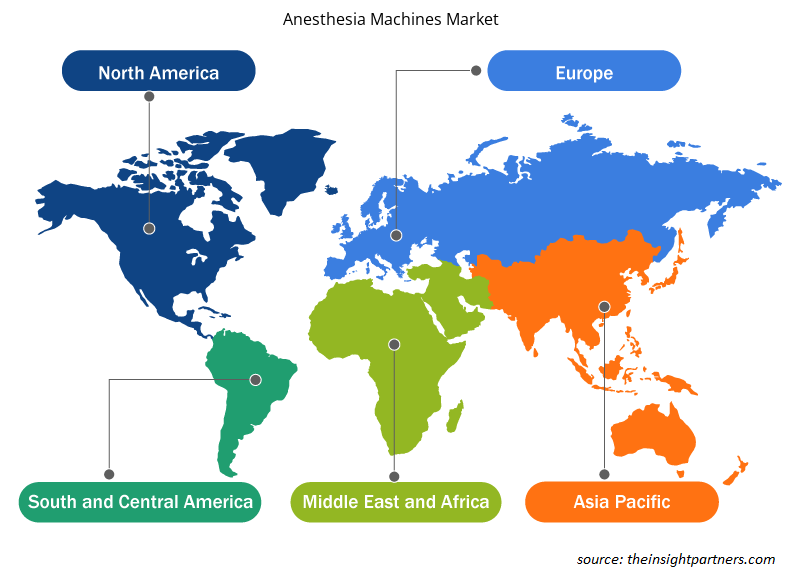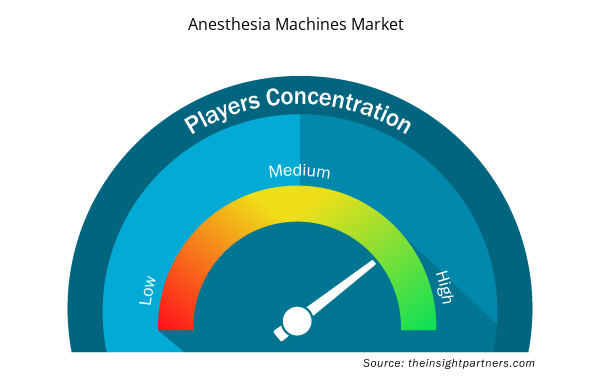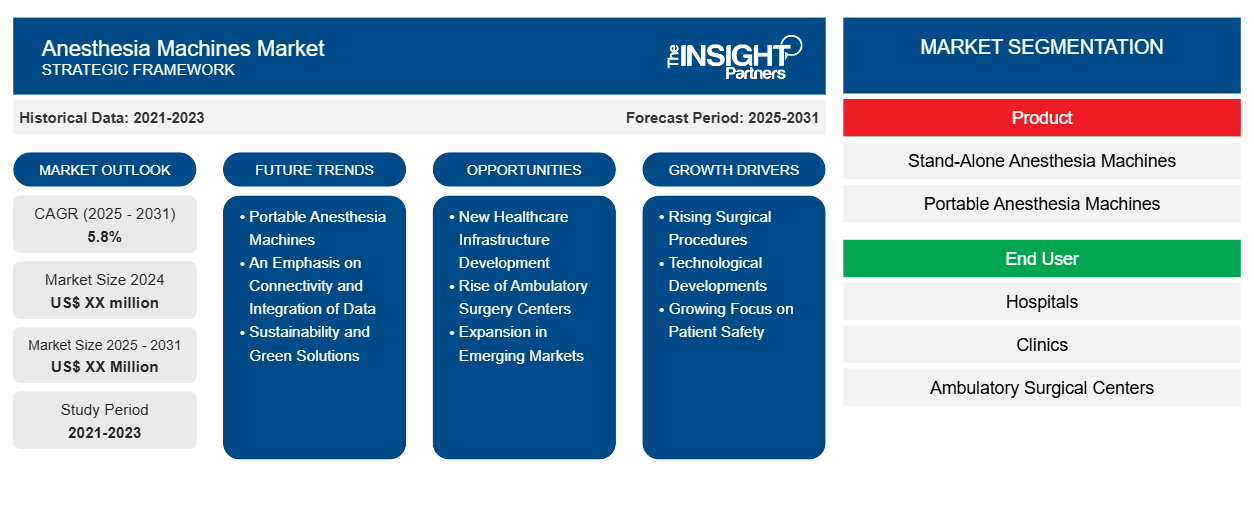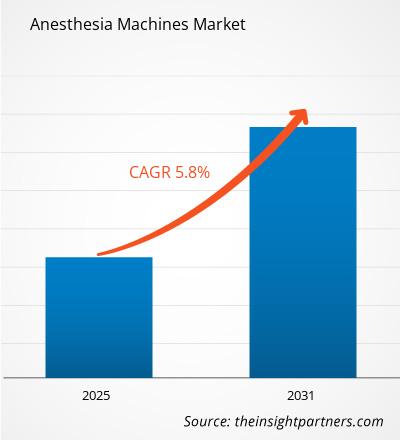Der Markt für Anästhesiegeräte soll zwischen 2024 und 2031 eine durchschnittliche jährliche Wachstumsrate (CAGR) von 5,8 % verzeichnen, wobei die Marktgröße von XX Millionen US-Dollar im Jahr 2024 auf XX Millionen US-Dollar im Jahr 2031 anwachsen soll.
Der Bericht ist nach Produkt (Stand-Alone-Anästhesiegeräte, tragbare Anästhesiegeräte) segmentiert. Darüber hinaus ist er nach Endbenutzer (Krankenhäuser, Kliniken, ambulante Operationszentren) segmentiert. Die globale Analyse ist weiter auf regionaler Ebene und nach wichtigen Ländern aufgeschlüsselt. Der Bericht bietet den Wert in USD für die oben genannte Analyse und Segmente.
Zweck des Berichts
Der Bericht „Markt für Anästhesiegeräte“ von The Insight Partners soll die aktuelle Situation und das zukünftige Wachstum sowie die wichtigsten Antriebsfaktoren, Herausforderungen und Chancen beschreiben. Dies wird verschiedenen Geschäftspartnern Einblicke geben, wie zum Beispiel:
- Technologieanbieter/-hersteller: Um die sich entwickelnde Marktdynamik zu verstehen und die potenziellen Wachstumschancen zu kennen, damit sie fundierte strategische Entscheidungen treffen können.
- Investoren: Durchführung einer umfassenden Trendanalyse hinsichtlich der Marktwachstumsrate, der finanziellen Marktprognosen und der Chancen entlang der Wertschöpfungskette.
- Regulierungsbehörden: Zur Regulierung von Richtlinien und Überwachungsaktivitäten auf dem Markt mit dem Ziel, Missbrauch zu minimieren, das Vertrauen der Anleger zu bewahren und die Integrität und Stabilität des Marktes aufrechtzuerhalten.
Marktsegmentierung für Anästhesiegeräte
Produkt
- Stand-Alone-Anästhesiegeräte
- Tragbare Anästhesiegeräte
Endbenutzer
- Krankenhäuser
- Kliniken
- Ambulante Chirurgische Zentren
Passen Sie diesen Bericht Ihren Anforderungen an
Sie erhalten kostenlos individuelle Anpassungen an jedem Bericht, einschließlich Teilen dieses Berichts oder einer Analyse auf Länderebene, eines Excel-Datenpakets sowie tolle Angebote und Rabatte für Start-ups und Universitäten.
- Holen Sie sich die wichtigsten Markttrends aus diesem Bericht.Dieses KOSTENLOSE Beispiel umfasst eine Datenanalyse von Markttrends bis hin zu Schätzungen und Prognosen.
Wachstumstreiber auf dem Markt für Anästhesiegeräte
- Zunahme chirurgischer Eingriffe: Ein weiterer wichtiger Treiber des Marktes für Anästhesiegeräte ist die Zahl der weltweit durchgeführten Operationen. Aufgrund des sich entwickelnden Gesundheitssystems und der wachsenden Bevölkerung werden die erforderlichen Eingriffe immer operativer, was zu einem steigenden Bedarf an zuverlässiger Anästhesieausrüstung führt. Dies beschleunigt in der Folge das Marktwachstum in allen Arten von Gesundheitseinrichtungen aufgrund der erhöhten Nachfrage nach sicheren und effizienten Anästhesiegeräten.
- Technologische Entwicklungen: Der Markt wird stark von der Geschwindigkeit beeinflusst, mit der der technologische Fortschritt in der Anästhesie voranschreitet. Technologische Fortschritte bei intelligenten Anästhesiegeräten, die bei der Überwachung der integrierten Anästhesie helfen, erhöhen die Sicherheit und vereinfachen die Prozesse. Die technologischen Verbesserungen haben zu besseren Ergebnissen bei operierten Patienten geführt, und Gesundheitsdienstleister sind motiviert, in neue Anästhesiegeräte zu investieren.
- Wachsender Fokus auf Patientensicherheit: Die zunehmende Betonung von Patientensicherheit und -komfort ist zur treibenden Kraft hinter dem Markt für Anästhesiegeräte geworden. Fortschrittliche Anästhesielösungen, die die Risiken solcher Behandlungen senken, rücken in den Mittelpunkt der Aufmerksamkeit von Krankenhäusern und chirurgischen Zentren. Dieser Fokus auf eine verbesserte Patientenversorgung wird die Nachfrage nach hochentwickelten Anästhesiegeräten fördern, die über alle neuesten Sicherheitsfunktionen verfügen.
Markttrends für Anästhesiegeräte
- Tragbare Anästhesiegeräte: In jüngster Zeit gewinnen tragbare Anästhesiegeräte durch den Trend zu mobilen Operationen und abgelegenen Standorten an Bedeutung. Diese leichten, kleinen Geräte gewährleisten eine angemessene Anästhesie in unterschiedlichen Umgebungen; sie sind praktisch für Menschen, die einen besseren Zugang zu chirurgischer Versorgung haben. Ihre Vielseitigkeit erregt die Aufmerksamkeit von Gesundheitsdienstleistern, insbesondere in unterversorgten Regionen.
- Schwerpunkt auf Konnektivität und Datenintegration: Zunehmender Trend auf dem Markt für Anästhesiegeräte Die Anbindung an elektronische Gesundheitsakten und Überwachungssysteme, Geräte, die einen nahtlosen Datenaustausch ermöglichen, und ein verbessertes Patientenmanagement haben zu allgemeinen Verbesserungen bei den Trends hinsichtlich Konnektivität und Datenintegration beigetragen. Die zunehmende Betonung auf die Steigerung der Effizienz von Arbeitsabläufen und Ergebnissen bei Patienten hat sie im Hinblick auf integrierte Lösungen attraktiver gemacht.
- Nachhaltigkeit und umweltfreundliche Lösungen: Nachhaltigkeitslösungen gewinnen auf dem Markt für Anästhesiegeräte zunehmend an Bedeutung, da Unternehmen Innovationen bei umweltfreundlichen Materialien und besseren Praktiken erforschen. Langsam werden die Aspekte Wiederverwendbarkeit, Abfallreduzierung und geringere Abfallerzeugung übernommen. Dieser Ansatz zur Umweltverantwortung ergibt eine gute Synergie und drängt Gesundheitsdienstleister zu umweltfreundlicheren Anästhesielösungen im klinischen Umfeld.
Marktchancen für Anästhesiegeräte
- Entwicklung einer neuen Gesundheitsinfrastruktur: Der Ausbau der Gesundheitsinfrastruktur gilt als wichtiger Wachstumsfaktor für den Markt für Anästhesiegeräte, insbesondere in Entwicklungsländern. Mit der Eröffnung neuer Krankenhäuser und chirurgischer Zentren wird die Nachfrage nach modernen Anästhesiegeräten steigen. Dies bietet den Herstellern zahlreiche Möglichkeiten, in neue Märkte einzutreten und den neuen Anforderungen expandierender Gesundheitseinrichtungen gerecht zu werden.
- Aufstieg ambulanter Operationszentren: Die Entwicklung ambulanter Operationszentren (ASCs) ist die größte Chance für Anästhesiegeräte. Da Operationen, die ambulant durchgeführt werden, immer häufiger werden und viel kürzere Rüstzeiten erfordern, steigt auch die Nachfrage nach kompakten und effizienten Anästhesiesystemen. Dies motiviert Hersteller, spezielle Geräte zu entwickeln, die genau definierte Anforderungen in ASCs erfüllen.
- Expansion in Schwellenmärkte: In Schwellenmärkten wird massiv in das Gesundheitswesen investiert; das bedeutet, dass es für Hersteller von Anästhesiegeräten eine fast ununterbrochene Abfolge von Möglichkeiten gibt. Die Investitionen in eine verbesserte Gesundheitsinfrastruktur in diesen Regionen bedeuten eine wachsende Nachfrage nach hochwertigen Anästhesielösungen. Unternehmen können diese Chance nutzen, indem sie kostengünstige, qualitativ hochwertige Geräte herstellen, die den Anforderungen der wachsenden medizinischen Infrastruktur gerecht werden.
Regionale Einblicke in den Markt für Anästhesiegeräte
Die regionalen Trends und Faktoren, die den Markt für Anästhesiegeräte im Prognosezeitraum beeinflussen, wurden von den Analysten von Insight Partners ausführlich erläutert. In diesem Abschnitt werden auch die Marktsegmente und die Geografie für Anästhesiegeräte in Nordamerika, Europa, im asiatisch-pazifischen Raum, im Nahen Osten und Afrika sowie in Süd- und Mittelamerika erörtert.

- Erhalten Sie regionale Daten zum Markt für Anästhesiegeräte
Umfang des Marktberichts über Anästhesiegeräte
| Berichtsattribut | Details |
|---|---|
| Marktgröße im Jahr 2024 | XX Millionen US-Dollar |
| Marktgröße bis 2031 | XX Millionen US-Dollar |
| Globale CAGR (2025 - 2031) | 5,8 % |
| Historische Daten | 2021-2023 |
| Prognosezeitraum | 2025–2031 |
| Abgedeckte Segmente | Nach Produkt
|
| Abgedeckte Regionen und Länder | Nordamerika
|
| Marktführer und wichtige Unternehmensprofile |
|
Dichte der Marktteilnehmer für Anästhesiegeräte: Auswirkungen auf die Geschäftsdynamik verstehen
Der Markt für Anästhesiegeräte wächst rasant, angetrieben durch die steigende Nachfrage der Endnutzer aufgrund von Faktoren wie sich entwickelnden Verbraucherpräferenzen, technologischen Fortschritten und einem größeren Bewusstsein für die Vorteile des Produkts. Mit steigender Nachfrage erweitern Unternehmen ihr Angebot, entwickeln Innovationen, um die Bedürfnisse der Verbraucher zu erfüllen, und nutzen neue Trends, was das Marktwachstum weiter ankurbelt.
Die Marktteilnehmerdichte bezieht sich auf die Verteilung von Firmen oder Unternehmen, die in einem bestimmten Markt oder einer bestimmten Branche tätig sind. Sie gibt an, wie viele Wettbewerber (Marktteilnehmer) in einem bestimmten Marktraum im Verhältnis zu seiner Größe oder seinem gesamten Marktwert präsent sind.
Die wichtigsten auf dem Markt für Anästhesiegeräte tätigen Unternehmen sind:
- Smiths Medical
- ALLGEMEINE ELEKTRIK
- Medtronic
- Spacelabs Gesundheitswesen
- Drägerwerk AG & Co. KGaA
Haftungsausschluss : Die oben aufgeführten Unternehmen sind nicht in einer bestimmten Reihenfolge aufgeführt.

- Überblick über die wichtigsten Akteure auf dem Markt für Anästhesiegeräte
Wichtige Verkaufsargumente
- Umfassende Abdeckung: Der Bericht deckt die Analyse von Produkten, Dienstleistungen, Typen und Endbenutzern des Marktes für Anästhesiegeräte umfassend ab und bietet einen ganzheitlichen Überblick.
- Expertenanalyse: Der Bericht basiert auf dem umfassenden Verständnis von Branchenexperten und Analysten.
- Aktuelle Informationen: Der Bericht stellt durch die Abdeckung aktueller Informationen und Datentrends Geschäftsrelevanz sicher.
- Anpassungsoptionen: Dieser Bericht kann angepasst werden, um spezifische Kundenanforderungen zu erfüllen und die Geschäftsstrategien optimal anzupassen.
Der Forschungsbericht zum Markt für Anästhesiegeräte kann daher dabei helfen, die Branchensituation und Wachstumsaussichten zu entschlüsseln und zu verstehen. Obwohl es einige berechtigte Bedenken geben kann, überwiegen die allgemeinen Vorteile dieses Berichts tendenziell die Nachteile.
- Historische Analyse (2 Jahre), Basisjahr, Prognose (7 Jahre) mit CAGR
- PEST- und SWOT-Analyse
- Marktgröße Wert/Volumen – Global, Regional, Land
- Branche und Wettbewerbsumfeld
- Excel-Datensatz



Report Coverage
Revenue forecast, Company Analysis, Industry landscape, Growth factors, and Trends

Segment Covered
This text is related
to segments covered.

Regional Scope
North America, Europe, Asia Pacific, Middle East & Africa, South & Central America

Country Scope
This text is related
to country scope.
Häufig gestellte Fragen
The rising surgical procedures and growing focus on patient safety are the major factors boosting the anesthesia machines market growth.
North America region accounts for highest revenue share in anesthesia machines market.
Asia Pacific is estimated to grow at the highest CAGR over the forecast period (2023 - 2031).
The anesthesia machines market is expected to grow at a CAGR of 5.8%.
The final report will duly include market size and projection estimates for all the segments from 2021 to 2031, along with a revenue share and compound annual growth rate (%) for the regional/country-wise market wherein 2021-2022 are the historic years, 2023 is considered to be the base year, and the forecast will be provided till 2031, along with CAGR (%).
Smiths Medical, GE Healthcare, and Medtronic are the major companies operating in the anesthesia machines market.
Trends and growth analysis reports related to Life Sciences : READ MORE..
The List of Companies
1. Smiths Medical
2. GENERAL ELECTRIC
3. Medtronic
4. Spacelabs Healthcare
5. Drägerwerk AG & Co. KGaA
6. BEIJING AEONMED CO., LTD.
7. HEYER Medical AG
8. Oricare, Inc.
9. BD
10. Supera Anesthesia Innovations
The Insight Partners performs research in 4 major stages: Data Collection & Secondary Research, Primary Research, Data Analysis and Data Triangulation & Final Review.
- Data Collection and Secondary Research:
As a market research and consulting firm operating from a decade, we have published and advised several client across the globe. First step for any study will start with an assessment of currently available data and insights from existing reports. Further, historical and current market information is collected from Investor Presentations, Annual Reports, SEC Filings, etc., and other information related to company’s performance and market positioning are gathered from Paid Databases (Factiva, Hoovers, and Reuters) and various other publications available in public domain.
Several associations trade associates, technical forums, institutes, societies and organization are accessed to gain technical as well as market related insights through their publications such as research papers, blogs and press releases related to the studies are referred to get cues about the market. Further, white papers, journals, magazines, and other news articles published in last 3 years are scrutinized and analyzed to understand the current market trends.
- Primary Research:
The primarily interview analysis comprise of data obtained from industry participants interview and answers to survey questions gathered by in-house primary team.
For primary research, interviews are conducted with industry experts/CEOs/Marketing Managers/VPs/Subject Matter Experts from both demand and supply side to get a 360-degree view of the market. The primary team conducts several interviews based on the complexity of the markets to understand the various market trends and dynamics which makes research more credible and precise.
A typical research interview fulfils the following functions:
- Provides first-hand information on the market size, market trends, growth trends, competitive landscape, and outlook
- Validates and strengthens in-house secondary research findings
- Develops the analysis team’s expertise and market understanding
Primary research involves email interactions and telephone interviews for each market, category, segment, and sub-segment across geographies. The participants who typically take part in such a process include, but are not limited to:
- Industry participants: VPs, business development managers, market intelligence managers and national sales managers
- Outside experts: Valuation experts, research analysts and key opinion leaders specializing in the electronics and semiconductor industry.
Below is the breakup of our primary respondents by company, designation, and region:

Once we receive the confirmation from primary research sources or primary respondents, we finalize the base year market estimation and forecast the data as per the macroeconomic and microeconomic factors assessed during data collection.
- Data Analysis:
Once data is validated through both secondary as well as primary respondents, we finalize the market estimations by hypothesis formulation and factor analysis at regional and country level.
- Macro-Economic Factor Analysis:
We analyse macroeconomic indicators such the gross domestic product (GDP), increase in the demand for goods and services across industries, technological advancement, regional economic growth, governmental policies, the influence of COVID-19, PEST analysis, and other aspects. This analysis aids in setting benchmarks for various nations/regions and approximating market splits. Additionally, the general trend of the aforementioned components aid in determining the market's development possibilities.
- Country Level Data:
Various factors that are especially aligned to the country are taken into account to determine the market size for a certain area and country, including the presence of vendors, such as headquarters and offices, the country's GDP, demand patterns, and industry growth. To comprehend the market dynamics for the nation, a number of growth variables, inhibitors, application areas, and current market trends are researched. The aforementioned elements aid in determining the country's overall market's growth potential.
- Company Profile:
The “Table of Contents” is formulated by listing and analyzing more than 25 - 30 companies operating in the market ecosystem across geographies. However, we profile only 10 companies as a standard practice in our syndicate reports. These 10 companies comprise leading, emerging, and regional players. Nonetheless, our analysis is not restricted to the 10 listed companies, we also analyze other companies present in the market to develop a holistic view and understand the prevailing trends. The “Company Profiles” section in the report covers key facts, business description, products & services, financial information, SWOT analysis, and key developments. The financial information presented is extracted from the annual reports and official documents of the publicly listed companies. Upon collecting the information for the sections of respective companies, we verify them via various primary sources and then compile the data in respective company profiles. The company level information helps us in deriving the base number as well as in forecasting the market size.
- Developing Base Number:
Aggregation of sales statistics (2020-2022) and macro-economic factor, and other secondary and primary research insights are utilized to arrive at base number and related market shares for 2022. The data gaps are identified in this step and relevant market data is analyzed, collected from paid primary interviews or databases. On finalizing the base year market size, forecasts are developed on the basis of macro-economic, industry and market growth factors and company level analysis.
- Data Triangulation and Final Review:
The market findings and base year market size calculations are validated from supply as well as demand side. Demand side validations are based on macro-economic factor analysis and benchmarks for respective regions and countries. In case of supply side validations, revenues of major companies are estimated (in case not available) based on industry benchmark, approximate number of employees, product portfolio, and primary interviews revenues are gathered. Further revenue from target product/service segment is assessed to avoid overshooting of market statistics. In case of heavy deviations between supply and demand side values, all thes steps are repeated to achieve synchronization.
We follow an iterative model, wherein we share our research findings with Subject Matter Experts (SME’s) and Key Opinion Leaders (KOLs) until consensus view of the market is not formulated – this model negates any drastic deviation in the opinions of experts. Only validated and universally acceptable research findings are quoted in our reports.
We have important check points that we use to validate our research findings – which we call – data triangulation, where we validate the information, we generate from secondary sources with primary interviews and then we re-validate with our internal data bases and Subject matter experts. This comprehensive model enables us to deliver high quality, reliable data in shortest possible time.


 Holen Sie sich ein kostenloses Muster für diesen Bericht
Holen Sie sich ein kostenloses Muster für diesen Bericht